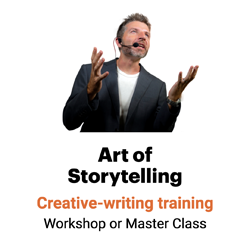Punch out your punch line
The punch line of a story is like the punch line of a joke — the place where you surprise your audience and make your point.

Hallmark’s late, great Gordon MacKenzie used this technique in his parable about the baby and the artist’s canvas in Orbiting the Giant Hairball, his delightful tome on corporate creativity. He writes:
‘Sure,’ you chirp. And you take the pristine canvas, roll it up, tuck it under your arm, and head off on your adventure.
When you are born, some doctor or nurse looks down at you in amazement and gasps, ‘Look! The little kid’s carrying a rolled-up artist’s canvas!’
Believing that you don’t yet have the skills to do anything meaningful with your canvas, the adults gently take it away from you and give it to society for safekeeping. But society can’t resist unrolling the canvas and drawing pale blue lines and pale blue numbers on its virgin surface. Eventually society gives the canvas back to you – its rightful owner – but with the implied message that if you will paint inside the pale blue lines and follow the instructions of the pale blue numbers, your life will be a masterpiece.
And that’s a lie.
Punch out your punch line.
To make the most of this powerful element, really punch out your punch line:
1. Tighten your setup.
Two straight lines followed by the punch line is the rule of thumb on the comedy circuit. Here, four fascinating paragraphs with longish sentences lull us into an expected rhythm, which MacKenzie breaks with the punch line.
2. Create a pause before the punch line.
Why slow the story down before you reach the end?
For the same reason stand-up comics pause and pan before delivering the punch line. The comedians are building tension in their audience members — tension that can be broken only by laughing. In comedy clubs, the greater the tension, the bigger the laugh. In storytelling, the greater the tension, the bigger the emotional payoff.
Whereas comedians can pause and pan, writers can create a slight pause before the punch line with the three P’s:
- Phrasing
- Punctuation
- Paragraphing
Notice how MacKenzie punches out his punch line through paragraphing. He builds the tension by making the last line a separate paragraph.
3. Put the punch line at the end.
Put the most powerful phrase at the end of the sentence, the end of the paragraph, the end of the anecdote.
We all have friends who tell jokes by starting with the punch line. Then they say, “Oh, I forgot to tell you, it was two ducks and the Pope in a bar.” And you’re thinking, “You know, nothing you say now is going to make this funny.”
The same is true of an anecdote. If you don’t withhold the important point until the end, the anecdote loses its power.
For those of us raised on the inverted pyramid, it takes a lot of discipline to withhold the revealing point until the end. But that’s the challenge of mastering new skills. Occasionally we have to temporarily put aside some of the techniques that brought us here in the first place.
Meanwhile, back at the masterpiece …
Fair disclosure: I was friends with MacKenzie and had the honor of editing his wonderful book. (An easier and more pleasant project there has never been.)
As a fan of MacKenzie — and as a fan of you! — I’ll share the end of his “masterpiece” story. Check out how he handles the punch line here:
But if you go to your grave without painting your masterpiece, it will not get painted.
No one else can paint it.
Only you.
See another example of punching out your punch line.

Leave a Reply